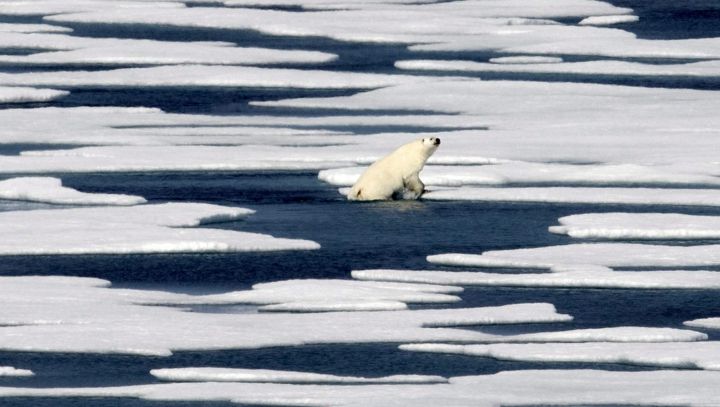A study published this week has painted a grim picture of the future of polar bears, particularly in the low Arctic.

The University of Toronto-led analysis puts estimated dates on when different polar bear groups will begin to struggle.
It says that within this decade, bear cubs in the south of Hudson Bay will move from being “likely” at risk to “highly likely” at risk, under an intermediate climate change scenario.
The report published in the journal Nature Climate Change says cubs in the Davis Strait and the west of Hudson Bay will follow a similar path in the decades afterwards.
Polar bears use sea ice as a way to hunt seals, but when the ice recedes, the bears take to dry land and eat less energy-rich foods, effectively fasting for the summer months.
As climate change causes further reductions in summer sea ice, the bears have been fasting for longer periods, with already noticeable effects on reproduction patterns.
“The first scientific study on polar bears and climate change was published in 1993. We have known that they will be impacted. The thing that we didn’t know is when they would be impacted,” said lead author Péter Molnár, an assistant professor in the department of biological sciences at U of T Scarborough.
“The results weren’t surprising, but it is nonetheless important. And I hope it emphasizes the urgency of the problem, now actually to be able to put a timeline on these changes.”
The study looked at 13 of the world’s 19 sub-populations of polar bears.

Under a more pessimistic climate scenario, it forecasts that young and/or adult bears will be “very likely” or “inevitably” at risk in 10 of the 13 regions by the end of this century.
Even the Queen Elizabeth Islands at the very north of Canada’s Arctic Archipelago would see cubs at “possible” risk by the 2080s.

Get breaking National news
“We basically asked two questions. The first one is, how long will polar bears have to live without ice? And as a consequence, how long will they have to fast in the future?” said Molnár.
“And the second question is, how long can they fast, given how fat they are and how much energy they need every day?”
Climate change predictions refined
The polar bear study comes in a week when another group of researchers narrowed down the certainty for how the planet’s surface will warm in response to increased levels of carbon dioxide (CO2) in the atmosphere — something known as ‘climate sensitivity.’
Since 1979, scientists have used a range that estimates that when atmospheric levels of CO2 double from pre-industrial levels, there is a 66 per cent chance the average global temperature will rise by between 1.5 and 4.5 degrees.
The new four-year analysis, published in the Review of Geophysics, was compiled by 21 scientists from around the world.
They say the likely range has been refined to “2.6C to 4.1C, with a best estimate of slightly above 3C,” adding that there is a less than five per cent chance that the temperature rise will be below two degrees and “a 6-18% chance it is above 4.5C.”
The planet has not doubled its CO2 levels yet, but current atmospheric levels are about 35 per cent above any pre-industrial era peak.
Most of that increase has happened in the past 40 years.
“The study kind of provides a balanced opinion, like we’re not doomed, but we also should not be too careless, because the Earth is going to warm in response to emitting CO2 to the atmosphere,” said one of the authors, Dr. Kasia Tokarska, with the Institute for Atmospheric and Climate Science in Zürich, Switzerland.

“I think it provides us a stronger kind of conviction about what we already know.”
This new, more focused temperature range cannot be mapped directly onto the two scenarios in the polar bear study, but it does suggest the intermediate scenario may be close to the best that can be hoped for, given our current trajectory of emissions.
The polar bear analysis used two of the so-called Representative Concentration Pathway (RCP) scenarios.
These scenarios track predicted levels of all greenhouse gases (GHG), not just CO2, in the atmosphere, based on how worldwide government policy and human behaviour will affect the concentration of GHG.
The researchers chose the intermediate RCP4.5 scenario, which sees GHG tapering off mid-century and flattening out before 2100.
Their second, pessimistic scenario is RCP8.5, a.k.a. “business as usual,” where GHG levels continue to rise sharply for the rest of the 21st century.
“If we manage to moderate, to mitigate, our emissions to the RCP4.5 scenario… then we unfortunately will still lose some polar bear populations of the southern edge of their range,” said Molnar.
“But we are giving the northern ones a better chance to survive.”
NASA’s analysis of Arctic sea ice indicates that the reduction is not slowing down.
It says the minimal extent of ice — annually observed in September — is dropping by 12.85 per cent per decade.
NASA observed the 2012 sea ice extent to be the lowest on record.









Comments